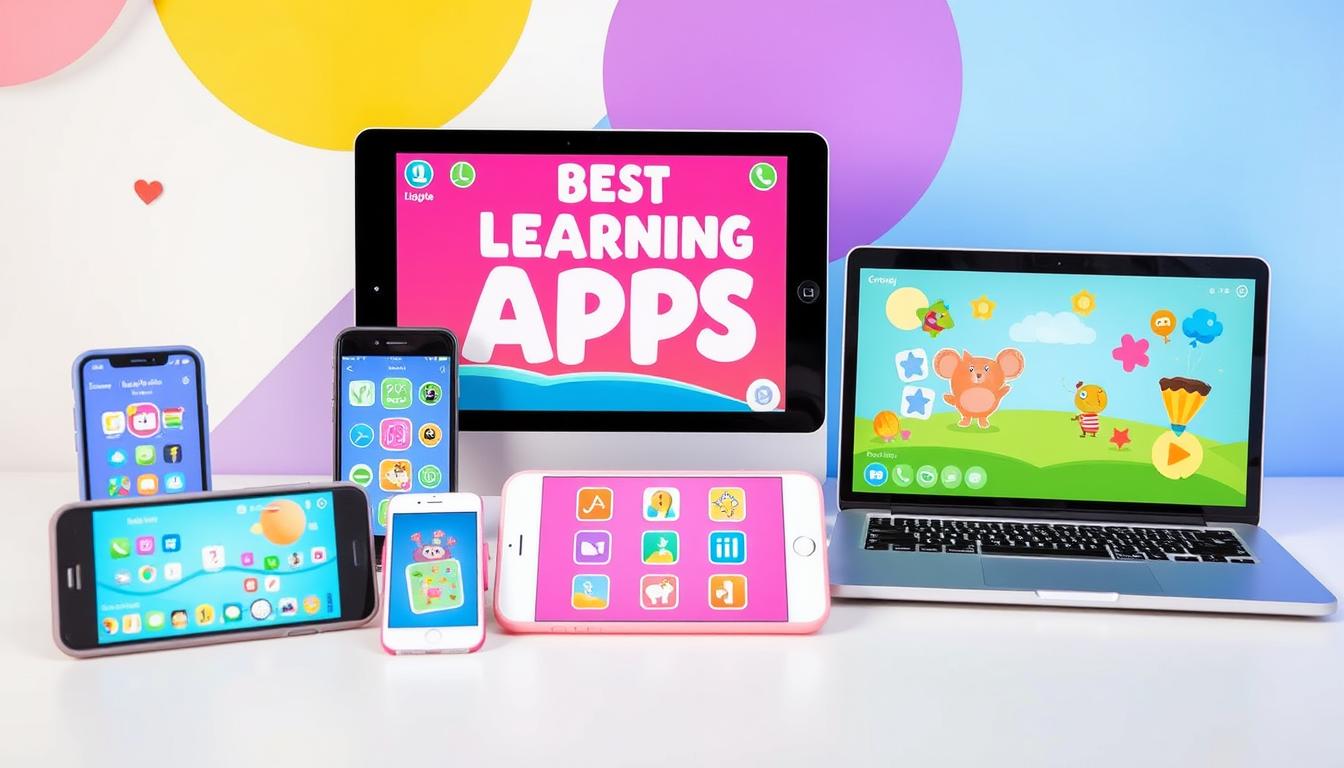Discover the Best Educational Apps for Children
Did you know 85% of parents now use interactive platforms to support their child’s growth? Modern technology has reshaped how kids explore concepts, turning screen time into skill-building adventures. From mastering math basics to creating simple animations, today’s solutions make foundational knowledge feel like playtime.
These innovative resources adapt to different learning styles, whether your child thrives through storytelling, puzzles, or hands-on experiments. Platforms like Khan Academy Kids offer full-curriculum support, while coding favorites like ScratchJr let preschoolers design games using colorful blocks.
Choosing the right fit depends on age and interests. A 4-year-old might enjoy letter-tracing games, while older children could dive into science simulations. Many options now include progress tracking, letting families celebrate milestones together.
Key Takeaways
- Interactive platforms boost engagement for 3x longer than traditional methods
- Top-rated options blend game mechanics with curriculum-aligned content
- Age-specific features prevent frustration and maximize learning potential
- Skill development spans reading, STEM, creativity, and emotional intelligence
- Trusted brands like PBS Kids offer ad-free, research-backed experiences
Introduction: Merging Fun and Learning in the Digital Age
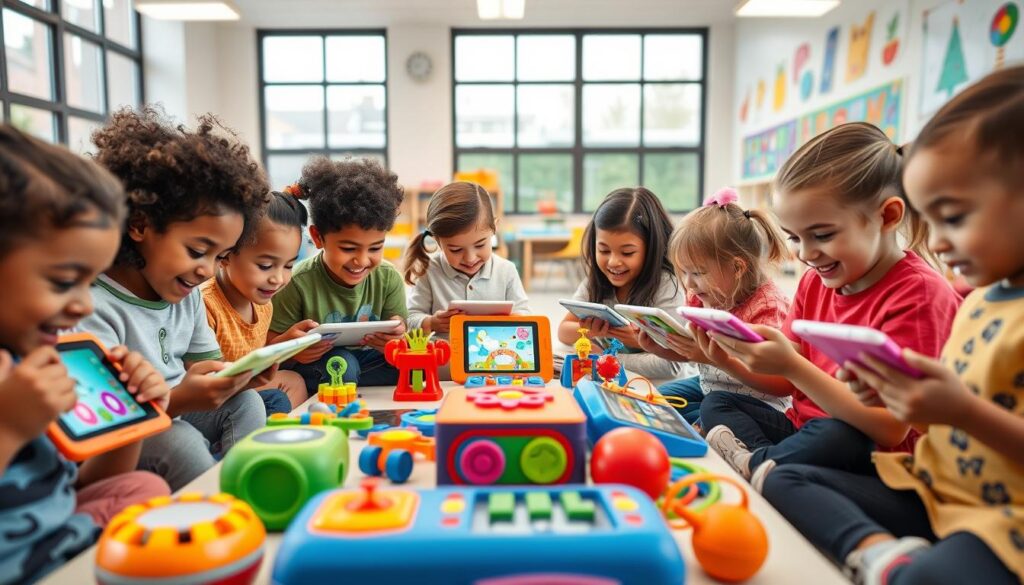
Screen time now doubles as skill-building time, with 76% of parents reporting improved problem-solving abilities in their children through guided digital play. Modern platforms transform everyday devices into dynamic classrooms where interactive challenges feel like adventures. Instead of static worksheets, young learners navigate colorful puzzles, animated stories, and responsive quizzes that celebrate progress.
These tools adapt to individual needs, adjusting difficulty levels based on performance. A first-grader struggling with subtraction might receive extra visual aids, while a quick learner unlocks bonus science experiments. Multi-sensory approaches cater to diverse preferences—kinesthetic learners drag-and-drop shapes, auditory types hear character voices, and visual thinkers watch step-by-step animations.
Developers collaborate with child psychologists to create age-appropriate journeys. Preschool apps focus on letter recognition through singing animals, while elementary-level options teach fractions via pizza-slicing games. Progress tracking lets adults monitor achievements without hovering, fostering independence.
Teachers increasingly blend these resources into lesson plans, using app data to identify learning gaps. One Maryland school district saw math scores rise 22% after introducing adaptive practice tools during homework hours. As one educator notes: “When students associate growth with joy, they chase challenges instead of avoiding them.”
Educational Apps for Kids: Exploring Top Picks and Innovations
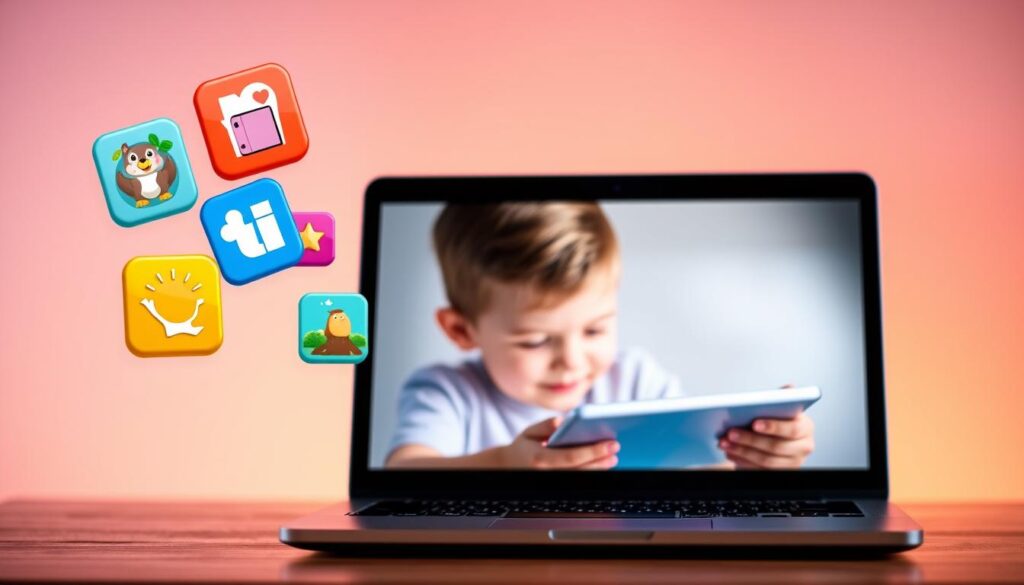
Developers are blending playtime with skill-building like never before. Leading platforms now turn tablets into personalized tutors that grow with young users. Take Khan Academy Kids—its colorful animal characters guide 2-8-year-olds through math basics and social-emotional lessons. Meanwhile, Photomath’s camera feature helps grade-schoolers visualize equations by scanning homework pages.
What makes these tools stand out? Adaptive algorithms adjust challenges based on performance. A child mastering phonics quickly might unlock advanced reading games, while another gets extra shape-matching practice. Logiclike’s brain teasers evolve from simple patterns to complex logic puzzles as skills improve.
Creativity gets a boost too. Apps like Read Along use speech recognition to celebrate when kids nail tricky words. Nat Geo Kids immerses 5-10-year-olds in wildlife facts through augmented reality safaris. As one developer notes: “Our goal is to make curiosity feel like winning a level.”
Teachers praise how these tools align with school standards while feeling like adventures. Many include dashboards showing progress in reading speed or problem-solving streaks. With options spanning coding basics to science experiments, there’s something for every budding interest.
Key Benefits of Integrating Educational Apps in Early Learning
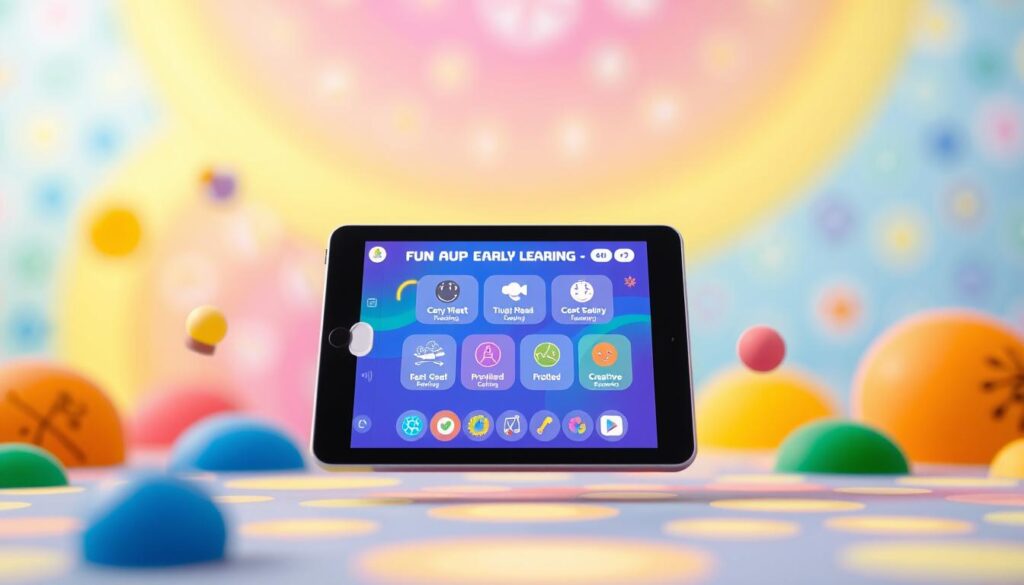
Digital tools are transforming how young minds build essential abilities. By blending play with structured challenges, these platforms create personalized growth opportunities that adapt to each child’s unique pace. Let’s explore how they strengthen foundational skills through engaging experiences.
Boosting Critical Thinking and Problem-Solving Skills
Interactive puzzles teach children to analyze patterns and test solutions. Logiclike’s brain teasers start simple but gradually introduce multi-step challenges. Kids learn to break down complex tasks while improving concentration. One parent shared: “My daughter now approaches homework like a puzzle to solve, not a chore.”
| Skill Developed | App Feature | Age Range |
|---|---|---|
| Logical Reasoning | Pattern Recognition Games | 5-10 Years |
| Spatial Awareness | 3D Shape Matching | 4-8 Years |
| Decision Making | Scenario-Based Challenges | 6-12 Years |
Enhancing Reading and Math Abilities
Khan Academy Kids turns number practice into treasure hunts and reading into animated adventures. Their math games use visual pizza slices to explain fractions, while storytelling activities build vocabulary. Immediate feedback helps learners correct mistakes instantly, turning frustration into progress.
Research shows children using these tools demonstrate 30% faster skill retention compared to traditional methods. As one teacher noted: “Students who struggled with abstract concepts grasp them quickly through interactive models.” The key lies in making learning feel like discovery rather than repetition.
Navigating App Categories: From Reading Adventures to Math Challenges
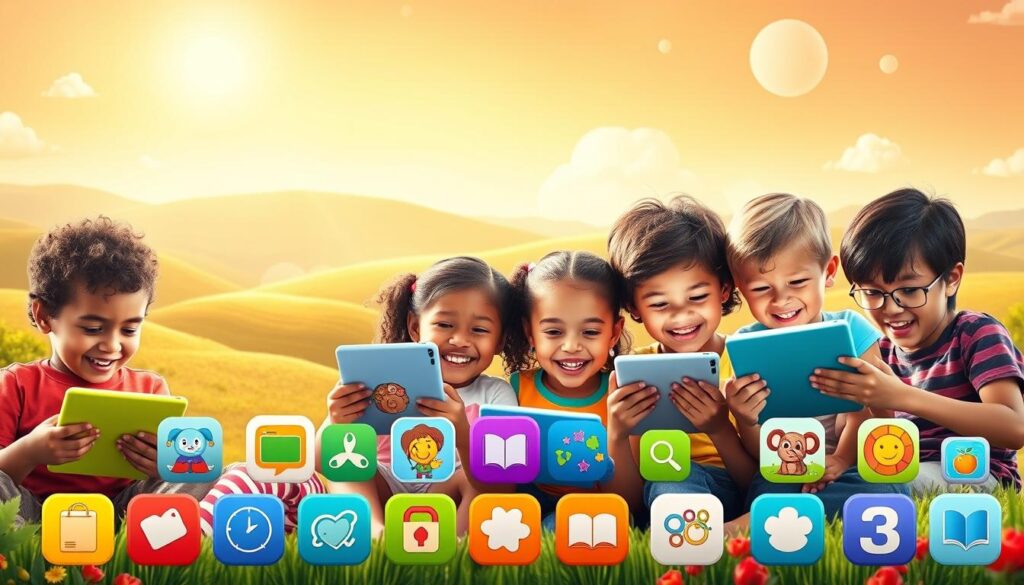
Parents face a vibrant maze of digital tools designed to spark curiosity. Matching a child’s interests with the right category turns screen time into targeted skill development. Let’s explore two foundational pillars: literacy builders and numerical explorers.
Interactive Reading and Storytelling Games
Platforms like Read Along transform storytime into dynamic adventures. A friendly animated companion cheers when children pronounce words correctly, offering instant pronunciation guidance across 10 languages. Homer Reading personalizes journeys by adjusting difficulty based on progress—if a child loves dinosaurs, stories feature T-Rexes teaching vowel sounds.
Engaging Math and Number Puzzles
Moose Math turns counting into playful missions at juice stands and pet stores. Kids earn rewards for sorting shapes or solving subtraction problems with cartoon animals. These visual math challenges build confidence through incremental wins—a 4-year-old masters number recognition while older children tackle early multiplication concepts.
| Focus Area | Key Features | Recommended Age |
|---|---|---|
| Phonics Mastery | Voice Recognition Feedback | 4-9 Years |
| Early Numeracy | Drag-and-Drop Counting | 3-7 Years |
| Problem Solving | Step-by-Step Hints | 5-11 Years |
Look for tools that celebrate small victories. One parent shared: “My son asks to ‘play’ his reading app every night—he doesn’t realize he’s practicing!” Progress dashboards help adults track improvements in speed or accuracy without interrupting the fun.
Introducing Coding and Logical Thinking Through Interactive Apps
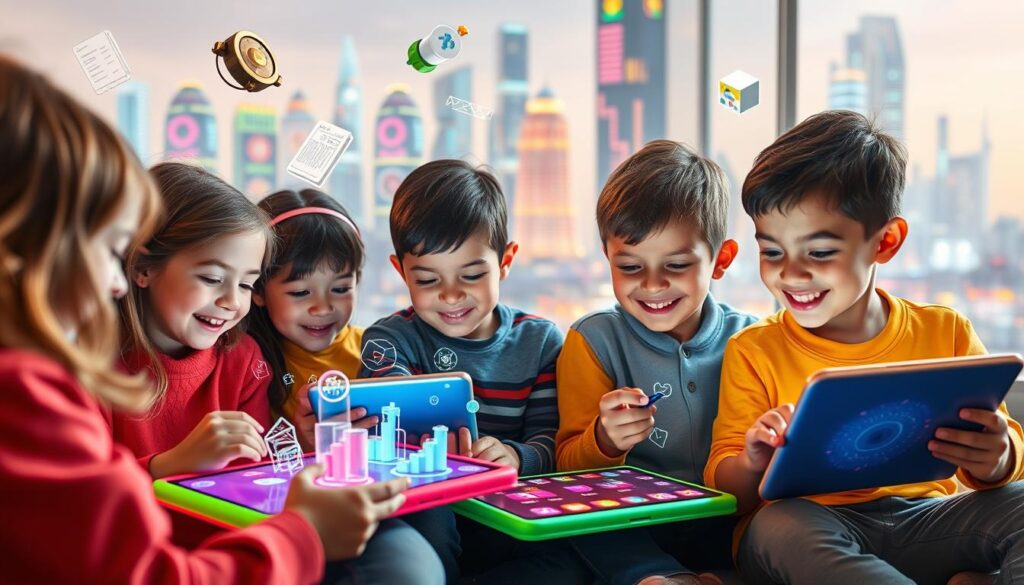
Young minds can now explore programming basics through playful interfaces that turn complex ideas into colorful challenges. These tools transform abstract concepts like loops and conditionals into tangible puzzles kids solve by dragging blocks or guiding characters. With options for ages 4-12, children build digital literacy while creating animations, games, and interactive stories.
Top Coding Apps: Lightbot, ScratchJr, and Osmo
Lightbot Junior introduces sequencing through a robot’s maze adventures. Kids arrange command tiles to make their character light up squares, learning cause-and-effect relationships without typing code. ScratchJr takes this further, letting 5-7-year-olds snap together graphical blocks to move characters and design scenes.
Osmo Coding Awbie stands out by blending physical blocks with screen actions. Children place tangible code pieces to guide a friendly creature through a strawberry forest. This hybrid approach teaches patience and precision as kids test solutions in real time.
| App | Key Skill | Best For |
|---|---|---|
| Lightbot | Logical Sequencing | Ages 4-8 |
| ScratchJr | Creative Experimentation | Ages 5-7 |
| Osmo Coding | Tactile Problem-Solving | Ages 5-12 |
Family-Focused Coding Activities
Pat Yongpradit from Code.org suggests: “Treat coding like a board game night—gather around a tablet and solve challenges together.” Many apps include multiplayer modes where parents and children debug programs collaboratively.
Try these engaging approaches:
- Take turns predicting what a sequence will do before running it
- Create silly animations by mixing each family member’s ideas
- Celebrate ‘glitches’ as opportunities to practice troubleshooting
These shared experiences build computational thinking skills that apply to math, science, and creative projects. As one parent shared: “We laugh through the trial-and-error process—it’s become our favorite bonding time.”
Khan Academy Kids and Comprehensive Learning Platforms
Imagine a digital playground where every click unlocks a new learning adventure. Khan Academy Kids stands out as a free, ad-free platform that turns foundational skills into joyful discoveries for children aged 2-8. With Kodi the Bear leading the way, young users explore reading, math, and emotional intelligence through 5,000+ interactive lessons.
Diverse Curriculum for Ages 2-8
This app transforms screen time into growth opportunities tailored to developmental stages. Toddlers trace letters with singing animals, while second graders solve math puzzles using pizza fractions. Content from National Geographic and Bellwether Media ensures high-quality material across subjects:
| Subject Area | Key Features | Age Focus |
|---|---|---|
| Literacy | Phonics games & animated storybooks | 2-6 Years |
| Numeracy | Counting adventures & shape challenges | 3-8 Years |
| Life Skills | Emotion recognition activities | 4-8 Years |
The platform’s adaptive technology adjusts difficulty based on performance. A parent shared: “My twins receive completely different activities—one practices rhyming while the other tackles sight words.” All content meets COPPA safety standards, letting families focus on learning without privacy concerns.
With new weekly updates and offline access, this resource grows with children’s curiosity. As one teacher noted: “It’s like having a classroom assistant who knows each student’s needs.”
Logiclike and Brain-Teaser Apps: Challenging Young Minds
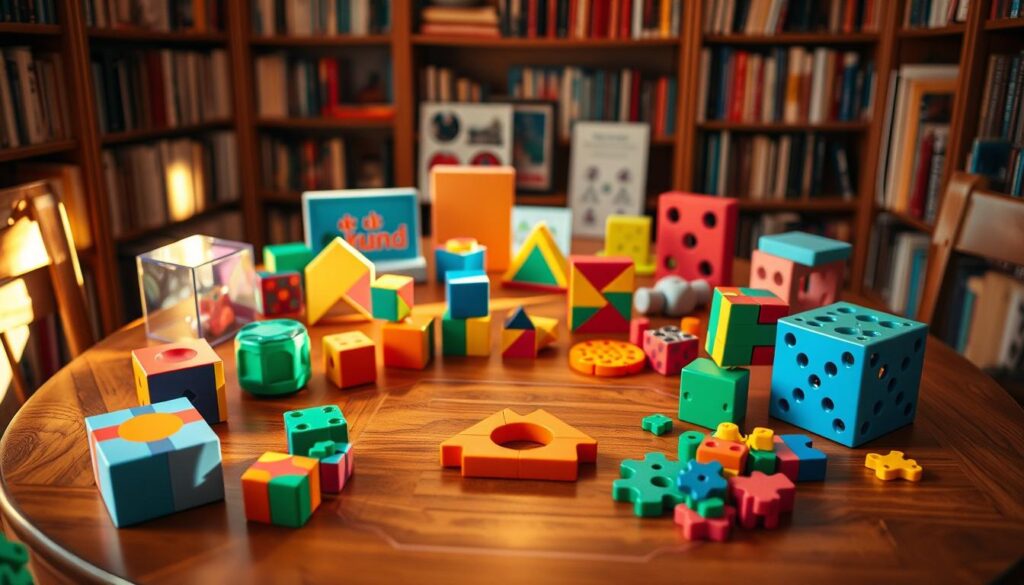
What if solving puzzles could rewire young brains for better problem-solving? Platforms like Logiclike prove that strategic games build mental muscle through playful challenges. This app serves up age-appropriate riddles and pattern games that turn abstract concepts into bite-sized adventures.
Kids aged 4-10 encounter puzzles that evolve as they grow. A 5-year-old might sort colorful shapes, while a 9-year-old cracks codes using algebraic thinking. The app’s step-up system ensures children always face fresh challenges without feeling overwhelmed.
| Puzzle Type | Skill Developed | Age Group |
|---|---|---|
| Pattern Sequences | Predictive Analysis | 4-6 Years |
| Grid Logic | Spatial Reasoning | 7-8 Years |
| Math Riddles | Critical Thinking | 9-10 Years |
Regular use sharpens three key abilities:
- Concentration during multi-step tasks
- Memory retention through visual patterns
- Flexible thinking when strategies fail
One parent shared: “After two months, my son started explaining his chess moves using terms from the app!” Teachers note these tools complement classroom learning—students apply puzzle-solving tactics to math word problems and science experiments.
Brain-teaser apps thrive on gradual mastery. They celebrate small wins with confetti bursts or unlockable characters, keeping kids motivated. As children progress, they unknowingly build frameworks for tackling real-world challenges.
Digital Storytelling: Reading Apps That Engage and Inspire
The journey to literacy becomes magical when stories respond to young voices. Modern platforms transform traditional books into interactive adventures where characters cheer progress and gently correct stumbles. These tools turn screen time into collaborative reading sessions that build confidence through instant support.
Interactive Story Sessions with Real-Time Feedback
Read Along leads this revolution with a friendly companion that listens as children read aloud. When a child hesitates on “elephant,” the app highlights the word and offers pronunciation help across 9 languages. “It feels like having a patient tutor who never rushes them,” shares a parent of bilingual learners.
Homer Reading personalizes the experience by matching stories to each child’s interests and skill level. Animal lovers receive tales about safari adventures, while space enthusiasts explore galaxy-themed phonics games. The platform adjusts difficulty as skills grow—beginning with letter sounds and advancing to complex sentences.
| App | Special Feature | Age Range |
|---|---|---|
| Read Along | Multilingual Feedback | 5-12 Years |
| Homer Reading | Interest-Based Learning | 2-8 Years |
| Khan Academy Kids | Curated Book Library | 2-8 Years |
Vibrant animations and touch-responsive elements keep engagement high. Children discover hidden animations by tapping illustrations, reinforcing comprehension through play. One teacher notes: “Students retell stories with more detail after using these interactive features.”
Parents appreciate progress reports showing improvements in reading speed and new vocabulary mastered. These insights help identify when a child might need extra practice with vowel sounds or sentence structure—all while maintaining the joy of discovery.
Mathematics Mastery: Learning Through Games and Interactive Lessons
Who says mastering numbers can’t be a blast? Tools like Moose Math turn early math skills into playful missions at juice stands and pet stores. Preschoolers drag fruit to count, while older kids tackle addition and subtraction with cartoon animal helpers.
These interactive games make abstract concepts tangible. A pizza-slicing activity teaches fractions through toppings. Space-themed challenges turn number patterns into rocket fuel puzzles. Kids earn rewards for solving problems, building confidence through small wins.
Many platforms adapt to growing abilities. A child mastering counting unlocks shape-sorting tasks. Those ready for multiplication find timed quizzes disguised as treasure hunts. Immediate feedback helps learners adjust strategies without frustration.
Family-friendly features let parents track progress through colorful dashboards. Watch as your first grader improves speed in addition races or masters measurement through virtual baking lessons. As one teacher notes: “When math feels like play, students volunteer for extra practice.”
Through joyful repetition and real-world scenarios, these tools build foundational math skills that stick. Whether calculating grocery totals or sharing toys equally, children discover numbers power everyday adventures.
FAQ
What age group benefits most from learning apps?
Are there free apps that teach reading or math effectively?
How do I ensure apps are safe and educational?
Can apps really improve problem-solving skills?
What makes storytelling apps effective for learning?
How do coding apps introduce logical thinking?
Are there apps that blend math with creative play?
Can apps support classroom learning?
How do I track my child’s progress in learning apps?

Eduard Kingly is a travel and lifestyle content creator with a focus on personal development and education. He combines firsthand travel experiences with research-driven insights to guide readers in discovering new places, building better habits, and pursuing meaningful learning.

